Lunosemyannik Daursky, Diseases and treatment of folk and medicinal products. Description, application and healing properties of herbs, alternative medicine. Moonseed Dahurian. Growing experience in Siberia.
It's beautiful climbing plant - liana, also called Amur ivy - grows wild along the Amur south of Khabarovsk, in the southern regions of Eastern Siberia and reaches Minusinsk on the Yenisei in the west, also grows in China and on the Korean peninsula. Most often, it lives along the edges of forests and along rivers, twining around shrubs and tall grasses.
Not recommended Exterminating collection of rhizomes: although the plant is currently not considered rare, intensive collection may lead to a reduction in the number of the species. Part of the population is located on the territory of the Pribaikalsky Natural National Park.
Moonseed- perennial dioecious herbaceous plant with green stems, dying to the ground for the winter. The rhizome is long, with thin roots. The leaves are beautiful, alternate, petiolate, rounded in general outline, indistinctly three-five-lobed, resembling ivy. Inflorescences racemose, bearing up to 30 flowers. The flowers are unisexual, small, greenish, staminate and pistillate flowers develop on different individuals. Pistillate specimens are very decorative in autumn, when black spherical drupe fruits appear. The stone is large, crescent-shaped (whence the name of the plant), with a ribbed outer edge. Flowering in May, fruiting in September.
For medicinal purposes, rhizomes with roots are collected. The whole plant contains alkaloids. In rhizomes with roots, they are 0.5-1%, mainly dauricin, in the aerial parts - up to 1% (sinomenin and acutumin). The drug from rhizomes with roots has a hypotensive effect.
In folk medicine Transbaikalia herb moonseed is used for gynecological diseases, febrile conditions, as a diaphoretic, expectorant, for pneumonia, diarrhea. Root tincture was used as a means of tonic activity of the gastrointestinal tract, improving metabolism, with cholecystitis and endometritis. Moonseed grass is used in Chinese and Tibetan medicine as an analgesic and diuretic, for nephritis, etc. A piece of moonseed root is applied to a sick tooth for toothache.
The berries of the moonseed are poisonous, so they should be wary of harvesting the plant., since when they are eaten, a rather persistent circulatory failure develops with a very serious general condition.
Tincture and decoction of the roots and rhizomes of the moonseed have a calming effect, reduce blood pressure, improve the efficiency and well-being of patients, reduce headaches and reduce the excitability of the vegetative nervous system. Clinical trials of dauricine, isolated from the rhizomes of the plant, showed its effectiveness in stage I and II hypertension. At the same time, in some patients who had pronounced sclerotic changes in blood vessels, under the action of the drug, the amount of cholesterol decreased and the amount of lecithin in the blood increased.
Decoction: 4-8 g of dry rhizomes and moonseed roots per 500 ml of water are boiled for 10 minutes, insisted for 30 minutes, filtered. Take 100 ml 3-4 times a day for acute respiratory diseases, tonsillitis, gum disease, furunculosis, hemorrhoids, as well as intestinal diseases.
Tincture: the roots and rhizomes of the moonseed are insisted on alcohol (1:8) for 15 days, filtered. Take 15-20 drops for hypertension.
Oil: crushed moonseed mixed with vegetable oil applied to the temples for headaches.
Lunosemyannik is widely used in ornamental gardening for landscaping walls, arbors. Extraordinarily picturesque green garlands of intertwining moonseed stems between trees and shrubs.
This medicinal plant contains the alkaloids dauricine, tetrandrine, sinomenin, tannins, resins, coumarins and saponins. For medicinal purposes, the roots and rhizomes of the moonseed are used, less often - grass and leaves. The underground part of the plant is harvested in autumn (October), the aboveground part - in May-June. The roots are cleaned from the remnants of the earth and pieces of stems, washed in water and dried under a canopy in the open air or in well-ventilated areas. Grass and leaves are dried without washing, in the usual way.
The use of moonseed
Scientific studies have found that decoctions and tinctures of the rhizomes of the plant reduce blood pressure, have a calming effect, improve the well-being and performance of patients. Moonseed preparations relieve symptoms and reduce the excitability of the autonomic nervous system.
Due to the content of the alkaloid dauricine, isolated from the roots, medicines based on moonseed are also effective in stage I and II hypertension. In patients with already existing sclerotic changes in blood vessels, under the influence of decoctions and infusions of the moonseed, the amount of lecithin in the blood decreases and the amount of lecithin increases. Thanks to sinomenin, plant preparations help well at high temperatures. They have an antitussive effect and have an anti-inflammatory effect. Moonseed holds good promise as a remedy for abscesses, and back pain.
In folk medicine, grass is prescribed for feverish conditions, gynecological diseases, and also as an expectorant and diaphoretic; it is used for pneumonia. Root tincture is used as a means of improving metabolism and tonic activity of the stomach and intestines, it is effective for cholecystitis and endometritis. The herb is also used as a pain reliever and diuretic.
Moonseed decoction: 2 teaspoons of dried and chopped rhizomes are required to be poured with two 2 cups of boiling water and simmer for 10-12 minutes, leave for at least half an hour and strain. It is advised to take the remedy three times a day, 1 tablespoon.
Moonseed tincture: 2 tablespoons of finely chopped dry leaves of the plant should be poured with a glass of boiling water, insisted for at least two hours until completely cooled, strain. Take the infusion three times a day, 0.25 ml.
Found a mistake in the text? Select it and a few more words, press Ctrl + Enter
Dahurian moonseed
It is a climbing herbaceous shrub. Its rhizome is vertical, not thick. Smooth stems up to three meters high annually partially die off. beautiful leaves arranged alternately on long petioles. The leaf blade is ovate, three to five lobed, with a triangular apex. The flowers are small, inconspicuous, dioecious, unisexual, greenish-white, growing in small racemes.
blooms this species moonseed from June to July, the seeds ripen in September. Its fruit is a black berry with a large single seed in the form of a moon. The plant propagates by dividing the rhizome, layering and seeds. In the wild, it grows in the Far East, in China, Japan. The plant winds around tall grasses and shrubs, on sands, screes along the banks of rivers.
Contraindications to the use of moonseed
In the moonseed, all parts are poisonous, and the underground is much larger than the aboveground. That is why the use of preparations from it requires caution, accurate dosage and consultation with a doctor.
Symptoms of berry poisoning: nausea, indigestion, in severe cases- Cardiovascular insufficiency. The patient should urgently wash the stomach with a solution of potassium permanganate or activated charcoal. Contraindications to the use of the plant are individual intolerance, pregnancy and lactation.
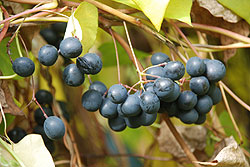
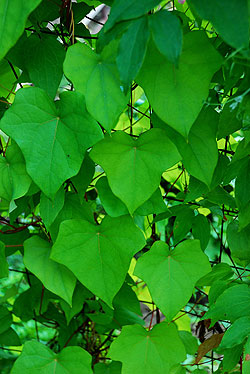
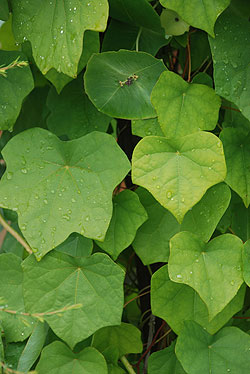

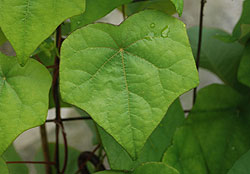
Observations for garden plants give a lot of interesting things. Here, for example, Dahurian moonseed (Menispermum dahuricum), by the way, it appeared in our garden in 2001. And he arrived from the regional center Rodniki of the Ivanovo region from the famous plant lover A.A. Saleev.
Scientists of the book unanimously say that this vine is dioecious. Of course, if you have a single specimen growing in your garden, there is no point in hoping for fruit. They simply have nowhere to appear: male plant does not produce them, and the feminine without the masculine cannot.
But you can see the immaculate conception, not fantasy at all, not a big fiction. It happens.
Amur ivy in front and in profile.
Moonseed Dahurian is a climbing semi-shrub liana. This means that its shoots are partly woody, and partly remain herbaceous. In practice, it all depends on age. Annual shoots are still thin as shoelaces, and completely herbaceous. With age, the lashes of the vines thicken to a diameter of 10-15 mm, and the degree, that is, the height of their lignification, increases. In particularly favorable winters, moonseed shoots can survive up to a 2-meter mark. As for the total height of the vine, it usually does not exceed 4 (max .5) m.
The most remarkable thing about the moonseed is its leaves. They are the size of linden trees, have relatively long (5-15 cm) petioles, entire, with 3-5 indistinct lobes, and symmetrical about the longitudinal axis. Interestingly, all the leaves are about the same size, and their tops are directed straight down, thus forming a kind of tiled mosaic. And the leaves of the moonseed, both in shape and size, are very similar to ivy leaves.
The moonseed blooms relatively late, around the beginning of June, and blooms for about three weeks. The flowers are whitish-green, small, dioecious, collected in small brushes. The fruits are spherical drupes with a diameter of about 10 mm, in small asymmetrical racemes of 5-12 pieces, blueberry-black at full maturity. The seeds are relatively large, semi-lunar in shape, which was the reason for giving the liana the name of the moon seed.
For you to know.
The lunar seed family ( Menispermaceae) (about 70 genera and 450 species) are mostly tropical and subtropical. Plants penetrating into temperate latitudes, in the family - once or twice and miscalculated. In Europe, there are no moon-seeds at all, and in Russia its only representative is just the hero of this plot, the Daurian moon-seed (Menispermum dahuricum), or amur ivy.
In the genus moonseed ( Menispermum) there are only two species, one in North America, the other in the Far East. Therefore, it seems strange that the family itself received the name of such a small representative. In ornamental horticulture, the Asian species, as more decorative, is used much more often than its American "colleague" Canadian moonseed (Menispermum canadense).
All parts of the moonseed are poisonous. Fruits are considered especially dangerous, if you eat them, you can get severe poisoning. However, few people want to eat berries that taste unpleasant.
At the same time, in small doses, the plant has a healing effect. In medicine, both the fruits and the roots of the moonseed are used. They have a sedative and hypotensive effect. They are used for hypertension, headaches, increased nervous excitability, endarteritis. The Chinese have identified an antitussive effect in the plant. The Japanese use it to treat rheumatism.
I'm trying to cut. And what came of it.
In fact, the moonseed will grow very actively with growth. Its horizontal stolon roots literally shoot in all directions. In this, the moonseed is similar to hops and. In our garden, the liana crawled even under the trodden path. Having emerged, on its other side, for a year or two she was looking for support for herself, and almost did not grow. Then, having found it, it went into growth and thus formed new center tillering. From this follows the conclusion - without support, the moonseed grows poorly.
Based on the property of the moonseed to form a lot of shoots (even in the absence of seeds), the main method of its reproduction is "coppice". But shoots do not appear in the vine so soon, but I wanted to quickly establish its reproduction.
First I tried green cuttings. Pushed around with them for three years - no result. Then he did the same with wood cuttings - zero. The third attempt - I cut the same woody cuttings, but not in the spring, but in the fall, and buried them in peat. I dug it out in the spring - everything is intact. Planted in a greenhouse, watching. At first everything went fine, the cuttings were alive, their buds began to grow, little by little the leaves were blooming. On part of the cuttings, the process of callus formation began. But then, one by one, the cuttings began to rot and fall out. In the end, out of three hundred cuttings, only one was able to root. Conclusion - cuttings of the moonseed are unproductive.
If the mountain does not go to Mohammed.
Winter 2013/2014 was exceptionally mild. The plants were expected to overwinter better than usual. And so it turned out, the moonseed overwintered more successfully than ever. His lashes remained intact to a height of more than a meter, while usually 20-50cm. However, there was nothing new to expect from this.
By this time, the moonseed had been growing in the garden for more than ten years and was so fed up with its appearance that I simply did not notice its flowering. Yes, and how to notice if the flowers are not only plain, but also carefully disguised in the thick of the crown. Well, the fruits from the vine (like from a goat's milk) were nothing to expect.
But things took a different turn. In early September, on my knees, I weeded the foot of the creeper. And suddenly, from this unusual vantage point inside the crown, I imagined black berries. - Can not be!
Spread the leaves - for sure! When I examined the entire vine, it turned out that there were quite a lot of fruits - a dozen and a half tassels. I soon collected them, and following the book's recommendations, I immediately sowed them. Shoots, according to the same books, should appear in May. We wait!
What happened to liana? How did she manage to set fruits? I have no idea about this. Let's assume that the plant heard my prayers.
Landing and care.
It would be wrong to say that the moonseed is picky. But he has a character that should be considered. If you describe his preferences very briefly, then the landing site should be sunny, and the soil should be quite fertile and aerated.
That this is important, I was convinced from my own experience, because at first I chose the wrong place - on the north side of the gazebo. Liana did not grow well there, and I was almost sure that it should be so. But the spirit of exploration pushed me to try other location options. Soon a place in the open sun turned up, with lighter soil, which I immediately took advantage of. And a miracle happened. The moonseed seemed to come to life from hibernation. In just three years, he developed a lot of shoots, and I was finally able to see what he was capable of.
Landing place. The soil. open sun, or slight penumbra with the removal of the crown to the "sun". close ground water and presence nearby large trees the liana is oppressed.
When planting a single bush, a hole should be dug about 40 cm deep and about 50 cm in diameter. The soil mixture can be made on the basis of leafy soil, humus and sand 1:1:2.
Fertilizer. Watering. Fertilizer moonseed is not only useful, but also desirable. But dig trunk circle it is forbidden. Therefore, the main method of application remains mulching with gradual incorporation. As a mulch, you can use a variety of organic matter - ventilated peat, fluffy humus, various composts. You can add mulch all season, as it is absorbed by the soil. When weeding, it is shown to “hide” organic matter into deeper horizons, while trying not to disturb the roots of the vine.
In the first half of summer (from the beginning of May to mid-July), it is useful at least once (and preferably twice) to carry out liquid top dressing with a “classic” herbal infusion. To do this, 2 tightly packed buckets of nettle grass are taken for a 200l barrel of water, and insisted for 2 weeks. The resulting "brazhka" liana is watered, adhering to the dosage - one bucket per bush, or two buckets per linear meter.
It is desirable to water the moonseed so often that the soil is constantly moderately moist. 3-4 days after watering, loosening is shown, and immediately add a new dose of mulch.
Amur instead of Carpathian.
Ivy (Hedera) has long been of interest to gardeners. I'm not an exception. Tried five of his cultivars. Two of them, having overcome all adversity, have become an indestructible part of our collection. True, they do not grow at all like in the pictures from France and Spain. That is, they grow, they grow, but they don’t form such chic green panels, because of which ivy is valued. In general, he does not behave like a liana, but like a ground cover. Instead of "climbing the wall" - it spreads. And if he climbs, then no more than a meter, and even then with separate lashes. In general, there is ivy, and there is no ivy.
Moonseed could be, if not a substitute, then a good imitation of ivy. Than-than, and with leaves, he is in no way inferior to him. Personally, the leaves of the moonseed are more attractive to me. Objectively, it is. Firstly, they are always fresh, their surface from spring to autumn yellowing remains immaculately clean and smooth. Secondly, the leaf mosaic that the moonseed forms is unusually elegant and pleasing to the eye. The liana itself, although it tends to creep, is not at all aggressive. As for the aerial part of the plant, then there are no complaints about it at all. In any case, the moonseed is more manageable than all grapes, including girlish (parthenocissus), and even than kirkazon with wood pliers. In addition, the presence of support "disciplines" the vine.
In general, the moonseed is an excellent decorative leafy vine with a good perspective in landscaping. As for winter hardiness, rumors about its insufficiency are clearly exaggerated.
Columns. Give the moonseed a columnar support, and it will turn it into a fairly even column with a diameter of about half a meter. The height of such a column can vary between 2 and 3m. This is the simplest landscaping technique, but in skillful hands it can look very fancy. The task of the designer is to arrange them beautifully. Imagine, for example, a living colonnade in the spirit of Greek basilicas, only without a “roof”, at the entrance to the hotel, at the monument, in the landscaping of the temple ...
Facade decoration. Hedges. In both cases, the main difficulty is support. First of all, it must be mesh. And its height can vary from 2.0m to 3.0m. For landscaping the walls, so that the liana "works" for its entire length, you can allow higher supports, up to 3.5 m. It is not recommended to use a chain-link as supports. It is better to make a grid on purpose, with a much rarer square cage than a chain-link - from 10 × 10 cm to 20 × 20 cm.
Arches. Green arches are now in vogue. And this trend is likely to last. Indeed, there is no more enticing element for decorating the entrance area than an arch. The arch, as if inviting to pass through it. No wonder the arches are now so popular with the owners of shops and small firms with a separate entrance. However, most often the arches are used independently, that is, without their landscaping. And it happens that they plant greenery with inanimate "plants". There are no words, it is also beautiful. And yet, the arch, entwined with a real liana, is at least more natural.
What you need to know - the arched support should be openwork, that is, welded from more or less thin rods, since the vine climbs with difficulty on the tubular arches, and does not hold well on them. Optimal Height arched opening - 2.5 m - maximum 3.0 m. A seedling is planted at each arched "leg". Heading towards, they will eventually completely hide the support itself under them.
A few years ago, I saw an interesting vine in the garden of a friend of mine. She asked for otvodochek, planted at home. It has been growing for me for the third year, it feels good, it winters well. The name of the friend did not know, I had to go through the Internet in search of this plant. It turned out that this is the Daurian moonseed. Its popular name: Amur ivy.
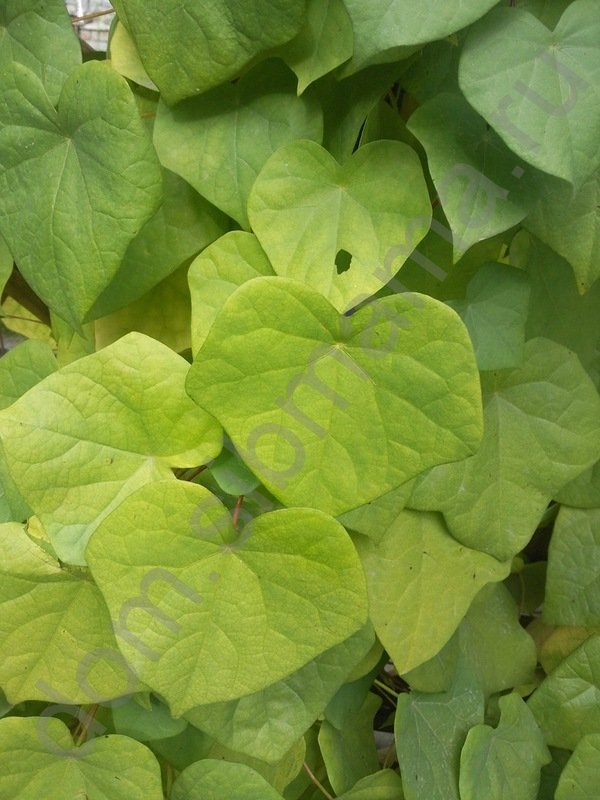
Daurian moon seed, Daurian menispermum (Menispermum dauricum) is a perennial herbaceous, rhizome, dioecious plant 2-3 m high, with climbing stems. Rhizome yellow-brown, long, branched, with thin roots. The leaves are alternate, dense, dark green, shield-shaped or wide-heart-shaped, sometimes three or five-lobed. The flowers are unisexual, small, greenish-yellow or greenish-pink, collected in axillary racemes. The fruit is a drupe, black, spherical, fleshy, with a flattened stone. Blooms in May - June. It grows along the edges of forests, banks of rivers and streams in the Primorsky Territory, in the south of the Khabarovsk Territory, in Transbaikalia and in the southern regions of Eastern Siberia, near Irkutsk. This is the only plant, from a very ancient family of lunosemyannikovye, growing in our country. The rest of its species are found mainly only in the tropics and subtropics.
In Russia, unfortunately, it is rarely grown.
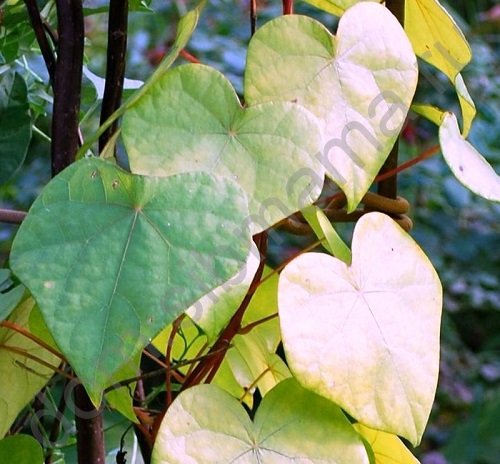
In the Novosibirsk region, the annual green herbaceous growth of moonseed, not having time to become woody, usually dies almost to the root neck, without actually forming a trunk, as a result, here the ground part of the plant rarely grows longer than 2 m. However, this does not affect the winter hardiness of the plant as a whole. Its rhizomes, roots and buds of renewal, hidden in the ground, like those of herbaceous perennials, are very frost and winter-hardy, therefore they do not die and shoot again in the spring.
In the southern part of the distribution area, growths that have matured and become lignified, which have become grayish-brown, usually freeze by 20-40 cm only at their uppermost end. Therefore, there the moonseed grows in length up to 5 m and even more.
The leaves are alternate, simple, dark green, shield-shaped, dense, smooth, leathery, with 3-7, more often 5 lobes, sometimes entire, up to 12 cm long, on long petioles. In autumn, the leaves turn yellow-brown, very decorative. They look like ivy leaves.
Winter-hardy, resistant to spring and autumn frosts. But in the first years after planting, it is still desirable to shelter it for the winter in places where there is not enough snow. Resistant to diseases and pests. Gas and smoke resistant. It acquires decorativeness in the second or third year, when the shoots become numerous and long enough. Grows well in shady places. Propagated by seeds, root offspring, layering, cuttings, dividing the bush. Runs wild easily.

Daurian moonseed is a medicinal plant.
Harvest grass during flowering; rhizomes with roots - in October.
The rhizomes contain alkaloids (2%): dauricine, tetrandrine, acutumine, acutumine, menisphelin, raurinoline, sinomenin. The content of alkaloids in grass and leaves is less than in rhizomes with roots.
It has anti-inflammatory, antipyretic and hypotensive effects; lowers the excitability of the autonomic nervous system. In hypertension, dauricin lowers blood pressure, increases the amplitude of heart contractions and relieves spasm of the coronary arteries.
Application.
Decoction: 4-8 g of dry rhizomes and moonseed roots per 500 ml of water are boiled for 10 minutes, insisted for 30 minutes, filtered. Take 100 ml 3-4 times a day for acute respiratory diseases, tonsillitis, gum disease, furunculosis, hemorrhoids, as well as intestinal diseases.
Tincture: the roots and rhizomes of the moonseed are insisted on alcohol (1:8) for 15 days, filtered. Take 15-20 drops for hypertension.
Oil: Crushed moonseed mixed with vegetable oil is applied to the temples for headaches. A piece of moonseed root is applied to an aching tooth for toothache.
Moonseed Daursky - Menispermum dauricum L
Lunosemyannikovye family - Menispermaceae Juss.
Dahurian moonseed is a herbaceous vine 2-5 m long. The stems are curly, wrapping around shrubs or grasses, or lying (where there is no suitable support). In most regions of the Far East, the stems are frosted to the ground, like in ordinary herbaceous perennials, but in the southern Primorye in the shrubbery there are specimens with a stem up to 3 m long, frosted only by 20-30 (50) cm. In such stems, the bark is dark gray, fissured , corky, diameter at the base of the stem 5-7 mm. The leaves are alternate, long-petiolate, shield-shaped, with 3-5 lobes, rarely entire, 6-12 cm long, leathery, shiny. The plant is dioecious. Flowers in short paniculate inflorescences, small, whitish-green. The fruits are black, juicy drupes up to 1 cm in diameter, with one large semilunar seed, with dark purple juice, poisonous. Seed with ribbed margin.
For medicinal purposes, grass, roots, rhizomes and leaves are used. The plant contains alkaloids 0.3%: acutumine, acutumidine, dauricine, sinomenine, menisperine, stefarine, magnoflorine, dauricinoline, as well as berberine, tannins, resins, triterpene saponins and coumarins. The leaves contain alkaloids: sinomenin, dysinomenin, stefarin, acutumine. The stems and leaves contain coumarins and flavonoids.
An infusion of the herb is used in Tibetan and Chinese medicine as an analgesic and diuretic for nephritis. Root tincture was drunk as a tonic for the gastrointestinal tract, improving metabolism, with endometritis and cholecystitis. Decoction of grass in Transbaikalia ethnoscience used in gynecological diseases, as an expectorant in pneumonia and diaphoretic in feverish conditions. Tincture and decoction of rhizomes reduce headaches, reduce the excitability of the autonomic nervous system, improve well-being, increase efficiency.
Synomenin has an antipyretic effect. Drugs from the leaves of Daurian moonseed lower blood pressure and increase the amplitude of heart contractions, without significantly affecting their rhythms.
It should be noted that the main active ingredient contained in the leaves is dauricine, and in the rhizomes - sinomenin. Dauricin steadily lowers blood pressure and is recommended for the treatment of grade I and II hypertension. At the same time, the content of cholesterol decreases and the amount of lecithin in the blood increases. Dauricin has 1/7 of the curare-like activity of tubocuranin. Synomen has an anti-inflammatory effect and is promising for the treatment of rheumatism, back pain, abscesses and boils, as well as a tonic, hypotensive, sedative.
The plant is poisonous. Cases of poisoning with berries are known, Moonseed is one of ornamental plants suitable for covering gazebos, fences and walls. However, given the toxicity of the fruit, only male specimens should be taken for planting.
Methods of preparation and use:
1. 2 tablespoons of dry crushed leaves per 200 ml of boiling water, leave for 2 hours, strain. Take 0.25 cup before meals 3 times a day for hypertension.
2. 2 tablespoons of Daurian moonseed grass per 200 ml of water, boil over low heat, leave for 1 hour, strain. Take 0.25 cups for gynecological diseases, feverish conditions and as an expectorant for pneumonia.
3. 2 teaspoons of crushed dry roots per 1 glass of water, boil over low heat for 4-5 minutes, leave for 1 hour, strain. Take 2 tablespoons before meals 3-4 times a day.


